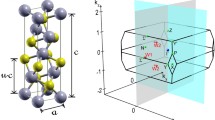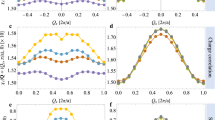Abstract
Two methods for stabilizing the two-hole 3 B 1g state as the ground state instead of the Zhang-Rice singlet are determined on the basis of an orthogonal cellular basis for a realistic multiband pd model of a CuO2 layer and the dispersion relations for the valence band top in undoped and doped cases are calculated. In the undoped case, aside from the valence band, qualitatively corresponding to the experimental ARPES data for Sr2CuO2Cl2 and the results obtained on the basis of the t-t′-J model, the calculations give a zero-dispersion virtual level at the valence band top itself. Because of the zero amplitude of transitions forming the virtual level the response corresponding to it is absent in the spectral density function. In consequence, the experimental ARPES data do not reproduce its presence in this antiferromagnetic undoped dielectric. A calculation of the doped case showed that the virtual level transforms into an impurity-type band and acquires dispersion on account of the nonzero occupation number of the two-hole states and therefore should be detected in ARPES experiments as a high-energy peak in the spectral density. The computed dispersion dependence for the valence band top is identical to the dispersion obtained by the Monte Carlo method, and the ARPES data for optimally doped Bi2Sr2CaCu2O8+δ samples. The data obtained also make it possible to explain the presence of an energy pseudogap at the symmetric X point of the Brillouin band of HTSC compounds.
Similar content being viewed by others
References
P. W. Anderson, Science 235, 196 (1987); R. O. Zaitsev and V. A. Ivanov, Fiz. Tverd. Tela (Leningrad) 29, 2554 (1987) [Sov. Phys. Solid State 29, 1475 (1987)].
P. Kuiper, G. Kruizinga, J. Chijsen, et al., Phys. Rev. B 38, 6483 (1988).
N. Nucker, J. Fink, J. C. Fugle, et al., Phys. Rev. Lett. 58, 2794 (1987).
V. J. Emery, Phys. Rev. Lett. 58, 2794 (1987).
C. M. Varma, S. Schmitt-Rink, and E. Abrahams, Solid State Commun. 62, 681 (1987).
Yu. B. Gaididei and V. M. Loktev, Phys. Status Solidi B 147, 307 (1988).
F. C. Zhang and T. M. Rice, Phys. Rev. B 37, 3759 (1988).
H. Eskes and J. H. Jefferson, Phys. Rev. B 48, 9788 (1993).
H. Eskes and G. A. Sawatzky, Phys. Rev. Lett. 61, 1415 (1988).
E. B. Stechel and D. R. Jennison, Phys. Rev. B 38, 4632 (1988).
H. Eskes, G. A. Savatzky, and L. F. Feiner, Physica C (Amsterdam) 160, 424 (1989).
J. H. Jefferson, H. Eskes, and L. F. Feiner, Phys. Rev. B 45, 7959 (1992).
S. V. Lovtsov and V.Yu. Yushankhai, Physica C (Amsterdam) 179, 159 (1991).
H.-B. Schutler and A. J. Fedro, Phys. Rev. B 45, 7588 (1992).
S. G. Ovchinnikov and I. S. Sandalov, Physica C (Amsterdam) 198, 607 (1989).
J. H. Jefferson, Physica B (Amsterdam) 165–166, 1013 (1990).
V. I. Belinicher, A. L. Chernyshev, and V. A. Shubin, Phys. Rev. B 53, 335 (1996).
A. Nazarenko, K. J. E. Vos, S. Haas, et al., Phys. Rev. B 51, 8676 (1995).
D. Daffy, A. Nazarenko, S. Haas, et al., Phys. Rev. B 56, 5597 (1997).
B. O. Wells, Z.-X. Shen, A. Matsuura, et al., Phys. Rev. Lett. 74, 964 (1995).
A. Bianconi et al., Physica C (Amsterdam) 162–164, 209 (1989).
H. Romberg et al., Phys. Rev. B 41, 2609 (1990).
L. F. Feiner, J. H. Jefferson, and R. Raimondi, Phys. Rev. B 53, 8751 (1996).
R. Raimondi, J. H. Jeferson, and L. F. Feiner, Phys. Rev. B 53, 8774 (1996).
S. G. Ovchinnikov, Phys. Rev. B 49, 9891 (1994).
C. G. Ovchinnikov, Zh. Éksp. Teor. Fiz. 107, 796 (1995) [JETP 80, 451 (1995)].
S. G. Ovchinnikov, Zh. Éksp. Teor. Fiz. 102, 534 (1992) [Sov. Phys. JETP 75, 283 (1992)].
S. G. Ovchinnikov, Pis’ma Zh. Éksp. Teor. Fiz. 64, 23 (1996) [JETP Lett. 64, 25 (1996)].
B. S. Shastry, Phys. Rev. Lett. 63, 1288 (1989).
R. O. Zaitsev, Zh. Éksp. Teor. Fiz. 68(1), 207 (1975) [Sov. Phys. JETP 41, 100 (1975)].
V. A. Gavrichkov, M. Sh. Erukhimov, S. G. Ovchinnikov, and I. S. Édel’man, Zh. Éksp. Teor. Fiz. 90, 1275 (1986) [Sov. Phys. JETP 63, 744 (1986)].
Z. Liu and E. Manousakis, Phys. Rev. B 45, 2425 (1992).
O. K. Andersen, A. Liechtenstein, O. Jepsen, and F. Paulsen, J. Phys. Chem. Solids 56, 1573 (1995).
G. Martinez and P. Horsch, Phys. Rev. B 44, 317 (1991).
E. Daggotto, F. Ortolani, and D. Scalapino, Phys. Rev. B 46, 3183 (1992).
G. Khaliullin and P. Horsch, Phys. Rev. B 47, 463 (1993).
G. G. Khaliullin, Pis’ma Zh. Éksp. Teor. Fiz. 52, 999 (1990) [JETP Lett. 52, 389 (1990)].
J. L. Richard and V. Yu. Yushankhai, Phys. Rev. B 50, 12927 (1994).
S. G. Ovchinnikov, Usp. Fiz. Nauk 167, 1043 (1997) [Phys. Usp. 40, 993 (1997)].
M. Guptasarma, D. G. Hinks, and M. V. Klein, Phys. Rev. Lett. 82, 5349 (1999).
D. S. Marshall et al., Phys. Rev. Lett. 76, 4841 (1996).
P. Prelovsek, J. Jaklic, and K. Bedell, Phys. Rev. B 60, 40 (1999).
A. P. Kampf and J. R. Schrieffer, Phys. Rev. B 41, 6399 (1990).
J. Schmalian, D. Pains, and B. Stoykovich, Phys. Rev. B 60, 667 (1999).
Author information
Authors and Affiliations
Additional information
__________
Translated from Zhurnal Éksperimental’no\(\overset{\lower0.5em\hbox{$\smash{\scriptscriptstyle\smile}$}}{l}\) i Teoretichesko\(\overset{\lower0.5em\hbox{$\smash{\scriptscriptstyle\smile}$}}{l}\) Fiziki, Vol. 118, No. 2, 2000, pp. 422–437.
Original Russian Text Copyright © 2000 by Gavrichkov, Ovchinnikov, Borisov, Goryachev.
Rights and permissions
About this article
Cite this article
Gavrichkov, V.A., Ovchinnikov, S.G., Borisov, A.A. et al. Evolution of the band structure of quasiparticles with doping in copper oxides on the basis of a generalized tight-binding method. J. Exp. Theor. Phys. 91, 369–383 (2000). https://doi.org/10.1134/1.1311997
Received:
Issue Date:
DOI: https://doi.org/10.1134/1.1311997




